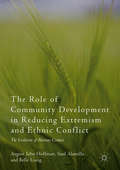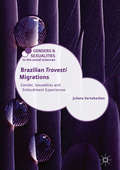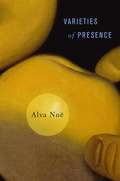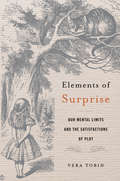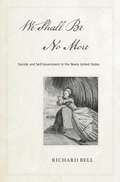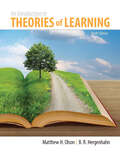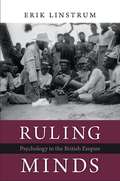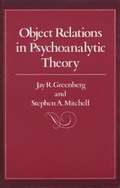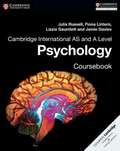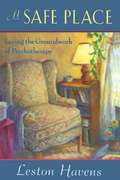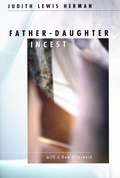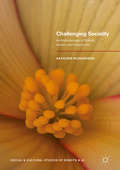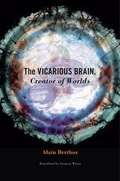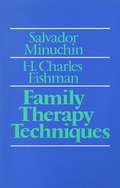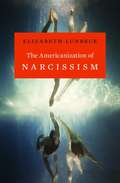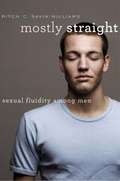- Table View
- List View
The Role of Community Development in Reducing Extremism and Ethnic Conflict: The Evolution of Human Contact
by August John Hoffman Saul Alamilla Belle LiangThe purpose of this text is to provide the reader with a comprehensive understanding of the nature of violence, aggression, extremism, and ethnic hate crimes in the US, and to explicate how community development, stewardship, and service may be implemented to address and reduce these problems. When individuals of diverse backgrounds are provided with engagement, interaction, and community-building stewardship programs, negative ethnic stereotypes are debunked, conflict is reduced, and individuals are more likely to communicate and build a more resilient and empowered community. Recent political and administrative policies have created a very tense environment among cities within the US, especially within communities that have larger populations of immigrant refugees and persons of varied ethnicities. This book aims to ameliorate some of that tension.
The Role of Community Development in Reducing Extremism and Ethnic Conflict: The Evolution of Human Contact
by August John Hoffman Saul Alamilla Belle LiangThe purpose of this text is to provide the reader with a comprehensive understanding of the nature of violence, aggression, extremism, and ethnic hate crimes in the US, and to explicate how community development, stewardship, and service may be implemented to address and reduce these problems. When individuals of diverse backgrounds are provided with engagement, interaction, and community-building stewardship programs, negative ethnic stereotypes are debunked, conflict is reduced, and individuals are more likely to communicate and build a more resilient and empowered community. Recent political and administrative policies have created a very tense environment among cities within the US, especially within communities that have larger populations of immigrant refugees and persons of varied ethnicities. This book aims to ameliorate some of that tension.
Brazilian 'Travesti' Migrations: Gender, Sexualities and Embodiment Experiences (Genders and Sexualities in the Social Sciences)
by Julieta VartabedianThis book sheds new light on the interconnections between identity, gender and geographical displacement. At its centre are Brazilian travesti migrants, assigned as male at birth but later seeking to convey the aesthetic attributes of women by repeatedly performing a minutely-studied type of femininity. Despite the fact that they have been migrating between Brazil and Europe for more than forty years, very little is know about them, especially in the English-speaking world. This work therefore fills a significant lacuna in our understandings of sexualities, bodies and trans issues, whilst rejecting hegemonic terms such as 'transsexual' and 'transgender' in favour of the specificity of the travesti. What it presents is an ethnographical study of their bodily and geographic-spatial migrations, analysing how they become travestis through the gendered modification of their bodies, their involvement in sex work, and the transnational migrations to Europe that many of them make. Examining their lives in both Brazil and Europe, it also analyses how their migrations influence the construction of their subjectivities. Drawing on extensive fieldwork in Brazil and Barcelona, this exciting book will appeal to all those interested in gender, sexuality and transgender issues.
Varieties of Presence
by Alva Noë Alva NoëThe world shows up for us, but, as Alva Noë contends in his latest exploration of the problem of consciousness, it doesn’t show up for free. We must show up, too, and bring along what knowledge and skills we’ve cultivated. As with a painting in a gallery, the world has no meaning—no presence to be experienced—apart from our able engagement with it.
Alien Landscapes?: Interpreting Disordered Minds
by Jonathan GloverDo people with mental disorders share enough psychology with other people to make human interpretation possible? Jonathan Glover tackles the hard cases—violent criminals, people with delusions, autism, schizophrenia—to answer affirmatively. He offers values linked with agency and identity to guide how the boundaries of psychiatry should be drawn.
Elements of Surprise: Our Mental Limits and the Satisfactions of Plot
by Vera TobinWhy do some surprises delight—the endings of Agatha Christie novels, films like The Sixth Sense, the flash awareness that Pip’s benefactor is not (and never was!) Miss Havisham? Writing at the intersection of cognitive science and narrative pleasure, Vera Tobin explains how our brains conspire with stories to produce those revelatory plots that define a “well-made surprise.” By tracing the prevalence of surprise endings in both literary fiction and popular literature and showing how they exploit our mental limits, Tobin upends two common beliefs. The first is cognitive science’s tendency to consider biases a form of moral weakness and failure. The second is certain critics’ presumption that surprise endings are mere shallow gimmicks. The latter is simply not true, and the former tells at best half the story. Tobin shows that building a good plot twist is a complex art that reflects a sophisticated understanding of the human mind. Reading classic, popular, and obscure literature alongside the latest research in cognitive science, Tobin argues that a good surprise works by taking advantage of our mental limits. Elements of Surprise describes how cognitive biases, mental shortcuts, and quirks of memory conspire with stories to produce wondrous illusions, and also provides a sophisticated how-to guide for writers. In Tobin’s hands, the interactions of plot and cognition reveal the interdependencies of surprise, sympathy, and sense-making. The result is a new appreciation of the pleasures of being had.
We Shall Be No More: Suicide And Self-government In The Newly United States
by Richard BellThough suicide is an individual act, Richard Bell reveals its broad social implications in early America. From Revolution to Reconstruction, everyone—parents, newspapermen, ministers and abolitionists alike—debated the meaning of suicide as a portent of danger or of possibility in a new nation struggling to define itself and its power.
Introduction to Theories of Learning: Ninth Edition
by Matthew H. OlsonDefines learning and shows how the learning process is studied. Clearly written and user-friendly, Introduction to the Theories of Learning places learning in its historical perspective and provides appreciation for the figures and theories that have shaped 100 years of learning theory research. The 9th edition has been updated with the most current research in the field. With Pearson's MySearchLab with interactive eText and Experiment's Tool, this program is more user-friendly than ever. Learning Goals Upon completing this book, readers should be able to: Define learning and show how the learning process is studied Place learning theory in historical perspective Present essential features of the major theories of learning with implications for educational practice Note: MySearchLab does not come automatically packaged with this text. To purchase MySearchLab, please visit: www.mysearchlab.com or you can purchase a ValuePack of the text + MySearchLab (at no additional cost).
Ruling Minds: Psychology in the British Empire
by Erik LinstrumThe British Empire used intelligence tests, laboratory studies, and psychoanalysis to measure and manage the minds of subjects in distant cultures. Challenging assumptions about the role of scientific knowledge in the exercise of power, Erik Linstrum shows that psychology did more to reveal the limits of imperial authority than to strengthen it.
A Clinical Introduction to Lacanian Psychoanalysis: Theory and Technique
by Bruce FinkArguably the most profound psychoanalytic thinker since Freud, and deeply influential in many fields, Jacques Lacan often seems opaque to those he most wanted to reach. These are the readers Bruce Fink addresses in this clear and practical account of Lacan's highly original approach to therapy. Written by a clinician for clinicians, Fink's introduction is an invaluable guide to Lacanian psychoanalysis, how it's done, and how it differs from other forms of therapy. While elucidating many of Lacan's theoretical notions, the book does so from the perspective of the practitioner faced with the pressing questions of diagnosis, which therapeutic stance to adopt, how to involve the patient, and how to bring about change.
Object Relations in Psychoanalytic Theory
by Jay GreenbergObject Relations in Psychoanalytic Theory offers a conceptual map of the most difficult terrain in psychoanalysis as well as a history of its most complex disputes. In exploring the counterpoint between different psychoanalytic traditions, it provides a synthetic perspective that is a major contribution to psychoanalytic thought. The focal point of clinical psychoanalysis has always been the patient’s relationships with others. How do these relationships come about? How do they operate? How are they transformed? How are relationships with others to be understood within the framework of psychoanalytic theory? Jay Greenberg and Stephen Mitchell argue that there have been two basic solutions to the problem of locating relationships within psychoanalytic theory: the drive model, in which relations with others are generated and shaped by the need for drive gratification; and various relational models, in which relationships themselves are taken as primary and irreducible. The authors provide a masterful overview of the history of psychoanalytic ideas, in which they trace the divergences and the interplay between the two models and the intricate strategies adopted by the major theorists in their efforts to position themselves with respect to these models. They demonstrate further that many of the controversies and fashions in diagnosis and psychoanalytic technique can be fully understood only in the context of the dialectic between the drive model and the relational models.
Object Relations in Psychoanalytic Theory
by Jay GreenbergObject Relations in Psychoanalytic Theory offers a conceptual map of the most difficult terrain in psychoanalysis as well as a history of its most complex disputes. In exploring the counterpoint between different psychoanalytic traditions, it provides a synthetic perspective that is a major contribution to psychoanalytic thought. The focal point of clinical psychoanalysis has always been the patient’s relationships with others. How do these relationships come about? How do they operate? How are they transformed? How are relationships with others to be understood within the framework of psychoanalytic theory? Jay Greenberg and Stephen Mitchell argue that there have been two basic solutions to the problem of locating relationships within psychoanalytic theory: the drive model, in which relations with others are generated and shaped by the need for drive gratification; and various relational models, in which relationships themselves are taken as primary and irreducible. The authors provide a masterful overview of the history of psychoanalytic ideas, in which they trace the divergences and the interplay between the two models and the intricate strategies adopted by the major theorists in their efforts to position themselves with respect to these models. They demonstrate further that many of the controversies and fashions in diagnosis and psychoanalytic technique can be fully understood only in the context of the dialectic between the drive model and the relational models.
Varieties of Presence
by Alva Noë Alva NoëThe world shows up for us, but, as Alva Noë contends in his latest exploration of the problem of consciousness, it doesn’t show up for free. We must show up, too, and bring along what knowledge and skills we’ve cultivated. As with a painting in a gallery, the world has no meaning—no presence to be experienced—apart from our able engagement with it.
Cambridge International As And A Level Psychology Coursebook
by Julia Russell Fiona Lintern Lizzie Gauntlett Jamie DaviesSkills-focused resources to support the study of Cambridge International AS and A Level Psychology (9990) for first examination in 2018. This vibrant coursebook is tailored to the Cambridge International AS and A Level Psychology (9990) syllabus for first examination in 2018 and is endorsed by Cambridge International Examinations. It contains rigorous, comprehensive coverage at the most appropriate level of depth and detail for the course. The coursebook contains extra focus on the key concepts of research methods and ethics as well as crucial debates such as nature versus nurture. The content encourages the development of necessary skills of analysis, interpretation, application and evaluation and promotes understanding of ethical and moral issues and their implications for psychological research.
A Safe Place: Laying The Groundwork Of Psychotherapy
by Leston HavensDrawing on his rich experience within psychiatry, Leston Havens takes the reader on an extraordinary journey through the vast and changing landscape of psychotherapy and psychiatry today. Closely examining the dynamics of the doctor–patient exchange, he seeks to locate and describe the elusive therapeutic environment within which psychological healing most effectively takes place.
Father-Daughter Incest: With a New Afterword
by Judith Lewis HermanThrough an intensive clinical study of forty incest victims and numerous interviews with professionals in mental health, child protection, and law enforcement, Judith Herman develops a composite picture of the incestuous family. In a new afterword, Herman offers a lucid and thorough overview of the knowledge that has developed about incest and other forms of sexual abuse since this book was first published. Reviewing the extensive research literature that demonstrates the validity of incest survivors' sometimes repressed and recovered memories, she convincingly challenges the rhetoric and methods of the backlash movement against incest survivors, and the concerted attempt to deny the events they find the courage to describe.
Cognitive Gadgets: The Cultural Evolution of Thinking
by Cecilia HeyesHow did human minds become so different from those of other animals? What accounts for our capacity to understand the way the physical world works, to think ourselves into the minds of others, to gossip, read, tell stories about the past, and imagine the future? These questions are not new: they have been debated by philosophers, psychologists, anthropologists, evolutionists, and neurobiologists over the course of centuries. One explanation widely accepted today is that humans have special cognitive instincts. Unlike other living animal species, we are born with complicated mechanisms for reasoning about causation, reading the minds of others, copying behaviors, and using language. Cecilia Heyes agrees that adult humans have impressive pieces of cognitive equipment. In her framing, however, these cognitive gadgets are not instincts programmed in the genes but are constructed in the course of childhood through social interaction. Cognitive gadgets are products of cultural evolution, rather than genetic evolution. At birth, the minds of human babies are only subtly different from the minds of newborn chimpanzees. We are friendlier, our attention is drawn to different things, and we have a capacity to learn and remember that outstrips the abilities of newborn chimpanzees. Yet when these subtle differences are exposed to culture-soaked human environments, they have enormous effects. They enable us to upload distinctively human ways of thinking from the social world around us. As Cognitive Gadgets makes clear, from birth our malleable human minds can learn through culture not only what to think but how to think it.
Challenging Sociality: An Anthropology of Robots, Autism, and Attachment (Social and Cultural Studies of Robots and AI)
by Kathleen RichardsonThis book explores the development of humanoid robots for helping children with autism develop social skills based on fieldwork in the UK and the USA. Robotic scientists propose that robots can therapeutically help children with autism because there is a “special” affinity between them and mechanical things. This idea is supported by autism experts that claim those with autism have a preference for things over other persons. Autism is also seen as a gendered condition, with men considered less social and therefore more likely to have the condition. The author explores how these experiments in cultivating social skills in children with autism using robots, while focused on a unique subsection, is the model for a new kind of human-thing relationship for wider society across the capitalist world where machines can take on the role of the “you” in the relational encounter. Moreover, underscoring this is a form of consciousness that arises out of specific forms of attachment styles.
Challenging Sociality: An Anthropology of Robots, Autism, and Attachment (Social and Cultural Studies of Robots and AI)
by Kathleen RichardsonThis book explores the development of humanoid robots for helping children with autism develop social skills based on fieldwork in the UK and the USA. Robotic scientists propose that robots can therapeutically help children with autism because there is a “special” affinity between them and mechanical things. This idea is supported by autism experts that claim those with autism have a preference for things over other persons. Autism is also seen as a gendered condition, with men considered less social and therefore more likely to have the condition. The author explores how these experiments in cultivating social skills in children with autism using robots, while focused on a unique subsection, is the model for a new kind of human-thing relationship for wider society across the capitalist world where machines can take on the role of the “you” in the relational encounter. Moreover, underscoring this is a form of consciousness that arises out of specific forms of attachment styles.
Insanity and Sanctity in Byzantium: The Ambiguity Of Religious Experience
by Youval RotmanIn the Roman and Byzantine Near East, the holy fool emerged in Christianity as a way of describing individuals whose apparent madness allowed them to achieve a higher level of spirituality. Youval Rotman examines how the figure of the mad saint or mystic was used as a means of individual and collective transformation prior to the rise is Islam.
The Vicarious Brain, Creator of Worlds
by Alain BerthozGroping around a familiar room in the dark, relearning to read after a brain injury, navigating a virtual landscape through an avatar: all are expressions of vicariance—when the brain substitutes one process or function for another. Alain Berthoz shows that this capacity allows humans to think creatively in an increasingly complex world.
Family Therapy Techniques
by Salvador Minuchin H. Charles FishmanA master of family therapy, Salvador Minuchin, traces for the first time the minute operations of day-to-day practice. Dr. Minuchin has achieved renown for his theoretical breakthroughs and his success at treatment. Now he explains in close detail those precise and difficult maneuvers that constitute his art. The book thus codifies the method of one of the country's most successful practitioners.
The Americanization of Narcissism
by Elizabeth LunbeckAmerican social critics in the 1970s seized on narcissism as the sickness of the age. But they missed the psychoanalytic breakthrough that championed it as the wellspring of ambition, creativity, and empathy. Elizabeth Lunbeck's history opens a new view on the central questions faced by the self struggling amid the crosscurrents of modernity.
Social Neuroscience: Brain, Mind, And Society
by Russell K. SchuttHuman beings evolved in the company of others. Mutually reinforcing connections between brains, minds, and societies have profound implications for physical and emotional health. Social Neuroscience offers a comprehensive new framework for studying human brain development and human behavior in their social context.
Mostly Straight: Sexual Fluidity among Men
by Ritch C. Savin-WilliamsA growing number of young men today say they are “mostly straight” and yet feel a slight but enduring desire for men. Ritch Savin-Williams explores the stories of 40 mostly straight young men to help us understand the biological, psychological, and cultural forces that are loosening the sexual bind many boys and young men experience.
